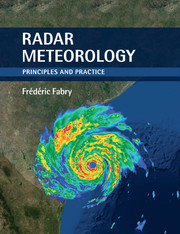Book contents
- Frontmatter
- Dedication
- Contents
- Preface
- Notation
- 1 Meteorology and radar
- 2 Fundamentals of weather radar measurements
- 3 Radar reflectivity and products
- 4 Reflectivity patterns
- 5 Doppler velocity information
- 6 The added value of dual polarization
- 7 Convective storm surveillance
- 8 Monitoring widespread systems
- 9 Radar estimation of precipitation
- 10 Nowcasting
- 11 Additional radar measurements and retrievals
- 12 Cloud and spaceborne radars
- 13 What does radar really measure?
- Appendix A Mathematics and statistics of radar meteorology
- References
- Index
13 - What does radar really measure?
Published online by Cambridge University Press: 05 June 2015
- Frontmatter
- Dedication
- Contents
- Preface
- Notation
- 1 Meteorology and radar
- 2 Fundamentals of weather radar measurements
- 3 Radar reflectivity and products
- 4 Reflectivity patterns
- 5 Doppler velocity information
- 6 The added value of dual polarization
- 7 Convective storm surveillance
- 8 Monitoring widespread systems
- 9 Radar estimation of precipitation
- 10 Nowcasting
- 11 Additional radar measurements and retrievals
- 12 Cloud and spaceborne radars
- 13 What does radar really measure?
- Appendix A Mathematics and statistics of radar meteorology
- References
- Index
Summary
Until this point, the radar measurement process has been treated as a black box, introducing in the early chapters only what was necessary to allow a nonresearch user to understand radar data and how they can be corrupted. But the capabilities of the instruments we use dictate what can be measured, and therefore influence our perception of reality. To properly comprehend what we observe, a good knowledge of the capabilities of the instrument we use is hence a prerequisite. For radar in particular, the dependence between what can be observed and the characteristics of the instrument is often complicated, being dictated by the complex relationships between the theoretical and engineering aspects of the measurement process together with the properties of the fields being observed. To answer the question “what does radar really measure” requires a deeper understanding of how the engineering, physical, and meteorological considerations are intertwined. This understanding is essential for a proper quantitative interpretation of observations.
In this chapter, the measurement process is reexamined by first studying it from the physics and engineering perspectives, and then completing the picture by adding meteorological considerations.
The radar system
Figure 13.1 and the electronic supplement e02.1 illustrate the basic elements of a radar system. In order to better understand them, we shall follow the many steps in the travels of a radar pulse, first focusing on the radar hardware.
13.1.1 From the transmitter to the antenna
The travels of radar waves start at the transmitter. For most weather radars, the transmit signal is generally a short high-power pulse shaped by a modulator or a waveform generator, although there are radars that use a continuous wave signal (Skolnik 2008). Transmitters can be subdivided into two families. In the first one, the radar pulse is generated by a high-power oscillator that is fed a strong pulse of current and emits a strong microwave pulse in exchange. The most common oscillator is the magnetron, which powers many radars and most microwave ovens.
- Type
- Chapter
- Information
- Radar MeteorologyPrinciples and Practice, pp. 201 - 214Publisher: Cambridge University PressPrint publication year: 2015



